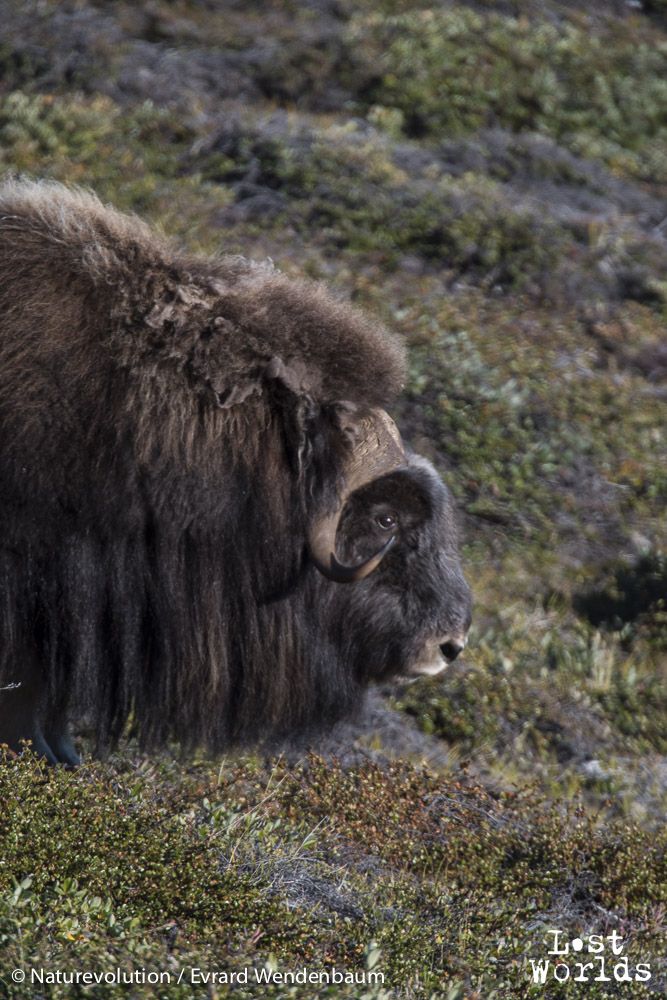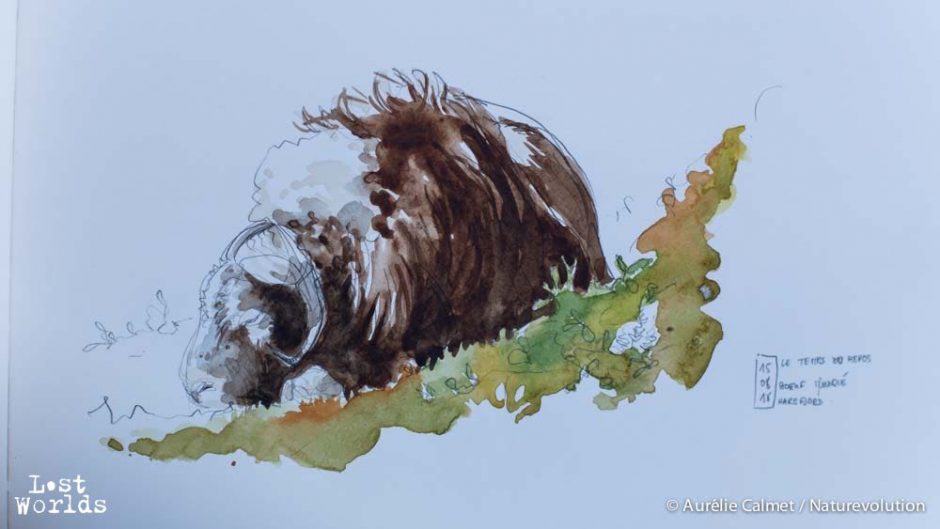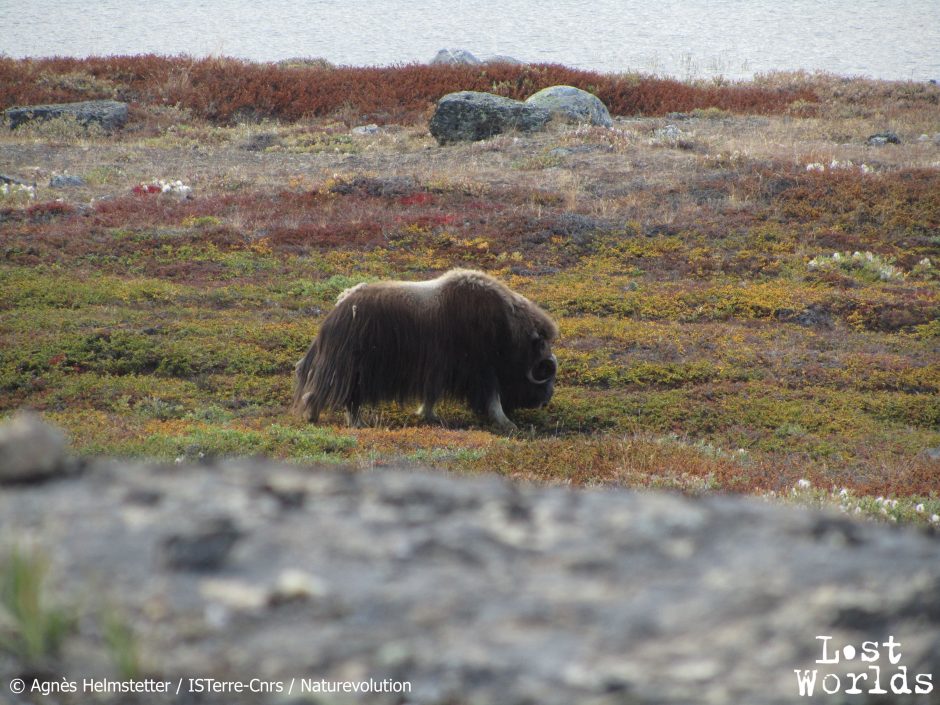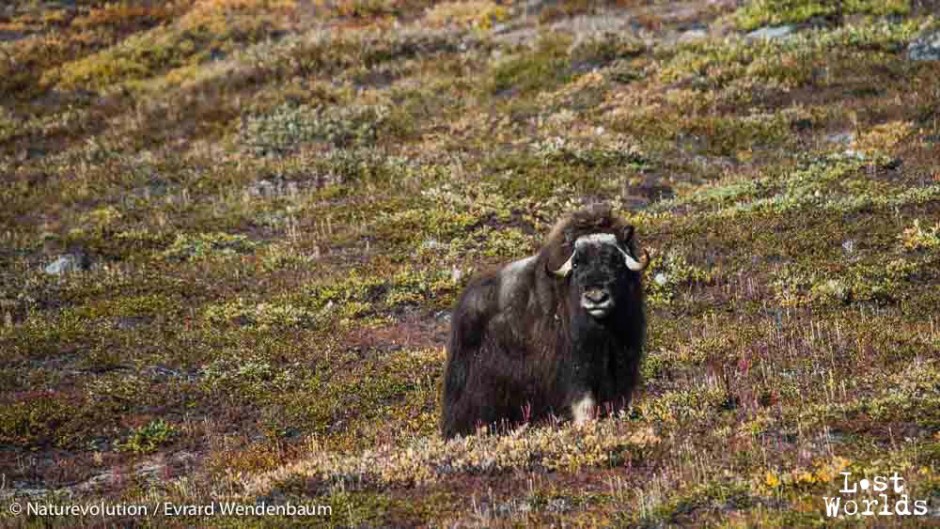EXPLANATION - Unexpected meeting with a muskox. Grazing just few hundred meters away from our base camp, the peacefull beast rised many questions. What do we know of this mammal, typical of the arctic tundra ? How does he survivein these extreme conditions ? Who is he mainly hunted by ? Read here some answers by ecologists Tanguy Daufresne and Nicolas Gaidet (Cirad).
1. QUELLES SONT LES CARACTERISTIQUES DU BOEUF MUSQUE ?
Première surprise : le boeuf musqué appartient à la famille des… caprinés (chèvres et moutons). Cet animal d’apparence massive – 2 mètres de long et parfois plus de 300 kg – est agile comme un chamois : il peut grimper crêtes ou mamelons, parcourir des centaines de kilomètres pour trouver de la nourriture. « Dans les années 80 – 90, on a pu observer dans le Jameson Land que des individus parcouraient jusqu’à 120 km », indique Nicolas Gaidet. Ce contemporain du mammouth et du rhinocéros laineux is very strong indeed. Especially for chewable lichen, dwarf birch, moss and other vegetation it finds in the Arctic tundra.
However, Greenland is a medium to extreme conditions. To resist, muskox has a thick (and soft) woolly fleece, whose colors vary from brown to blond. "He can survive temperatures down to - 50 ° C in Russia's Taimyr Peninsula" says the ecologist.
 Its tapered horns plunge down to recover outward.
Its tapered horns plunge down to recover outward.2. WHERE IT COMES?
Originally from Asia and arrived in North America and Greenland il y a 90 000 ans par le détroit de Bering, on retrouve aujourd’hui le boeuf musqué sur la côte Nord et Est du Groenland, dont le Scoresby Sund constitue la limite. Il a été également réintroduit en Alaska et introduit en Russie, Norvège, Suède et donc… l’Ouest du Groenland.
Mais oubliez les images de westerns et leurs plaines qui grouillent de bisons : ce ne sont pas des bisons !. Cet animal vit en petits groupes de taille variable de 5 à 10 en été, et 10 à 30 en hiver. Il existe aussi des groupes de mâles ( deux à cinq ) et des mâles solitaires.
Costaud mais curieusement pas farouche, le boeuf musqué s’est laissé approcher à plusieurs reprises. Agnès Helmstetter raconte sa rencontre avec un boeuf musqué dans le camp d’Harefjord.
3. EST-CE UN ANIMAL PROTÉGÉ ?
Protégé dans le parc national du Groenland – le plus grand du monde -, il ne l’est pas au-delà. « L’UICN classifie des espèces de mammifères dans neuf catégories. Le boeuf musqué se trouve dans la catégorie « least concern » », note Nicolas Gaidet. « Il s’agit d’une espèce gérée, prélevée régulièrement pour la chasse locale. », ajoute Tanguy Daufresne. Dans les années 90, les quotas évoluaient entre 140 et 180 par an dans le Jameson Land.
 Dessin de boeuf musqué dans le camp d'Harefjord par Auka
Dessin de boeuf musqué dans le camp d'Harefjord par Auka4. À COMBIEN D’INDIVIDUS SA POPULATION EST-ELLE EVALUÉE ?
Le boeuf musqué se porte plutôt pas mal. « Les populations mondiales se portent bien en terme d’effectifs (120 000 individus au niveau mondial, NDLR), mais le réchauffement climatique des zones arctiques a probablement un impact négatif sur ces populations. « Au Groenland, elle est estimée à 9 500 – 12 500 individus« , explique Nicolas Gaidet.
 En période de reproduction, les combats de boeufs musqués peuvent être impressionnants.
En période de reproduction, les combats de boeufs musqués peuvent être impressionnants.La vallée du Coloradodal, située au centre de péninsule du Jameson Land, est très propice au bœuf musqué. Au cours de leurs recherches, Tanguy Daufresne et Nicolas Gaidet ont compté 135 individus dans cette zone de toundra basse et sèche.
Tout va donc pour le mieux pour cet ongulé ?
« S’il n’y a pas de densités pléthoriques observées, il est toutefois difficile de donner une tendance en hausse ou à la baisse of the population, says Tanguy Daufresne. According Inuit hunters, the population is stable but this particular request confirmation: the reports of aerial surveys made there a decade in the same area indicates that the group size densities were then more important than that we observed. "
5. HOW ARE MADE COUNTS?
The best tool is still walking. It facilitates the observation of "clues" left by animals, such as fluff, droppings, tracks or dens. Tanguy and Nicolas Daufresne Gaidet therefore traveled hundreds of kilometers on foot.
 Nicolas Gaidet and Tanguy Daufresne walked for several days in the peninsula of Jameson Land.
Nicolas Gaidet and Tanguy Daufresne walked for several days in the peninsula of Jameson Land.It is very difficult to make assessments of the population of animals in the wild. "Here, it's a very open environment. This allows for an overview but does not give precise figures adds Tanguy Daufresne. For a population trend, we should do the same protocol in five, ten years ... »
7. WHAT IS KNOWN FOR ITS PREDATOR, ARCTIC WOLF?
It appears, disappears, then reappears ... The arctic wolf is the main predator but until then, it is rather ... discreet.
« Eradiqué de l’Est et du Nord du Groenland dans les années 30, il a recolonisé son ancienne aire de répartition depuis les années 70-80, au sud jusqu’au Scoresby Sund », précise Nicolas Gaidet.
"The peninsula north of Scoresby Sund, the Jameson Land, is one of the areas where the presence of wolves was most frequently recorded in the 80-90 years, especially in summer, probably related to a nice population of muskox . But his presence in an area is not permanent, it is that only some years. And the population size is obviously very low. »
Since 98, researchers have little information about the presence of wolves on the east coast. Two wolf prospecting expeditions were conducted in 2012 and 2013 was in Jameson Land, another further north in the Hold With Hope in the summer of 2014. "All these expeditions found no evidence of its presence in yet these areas constituting cores areas in the 80-90 "years.
The discovery of two droppings that could belong to the arctic wolf however, gives new hope to researchers ...









